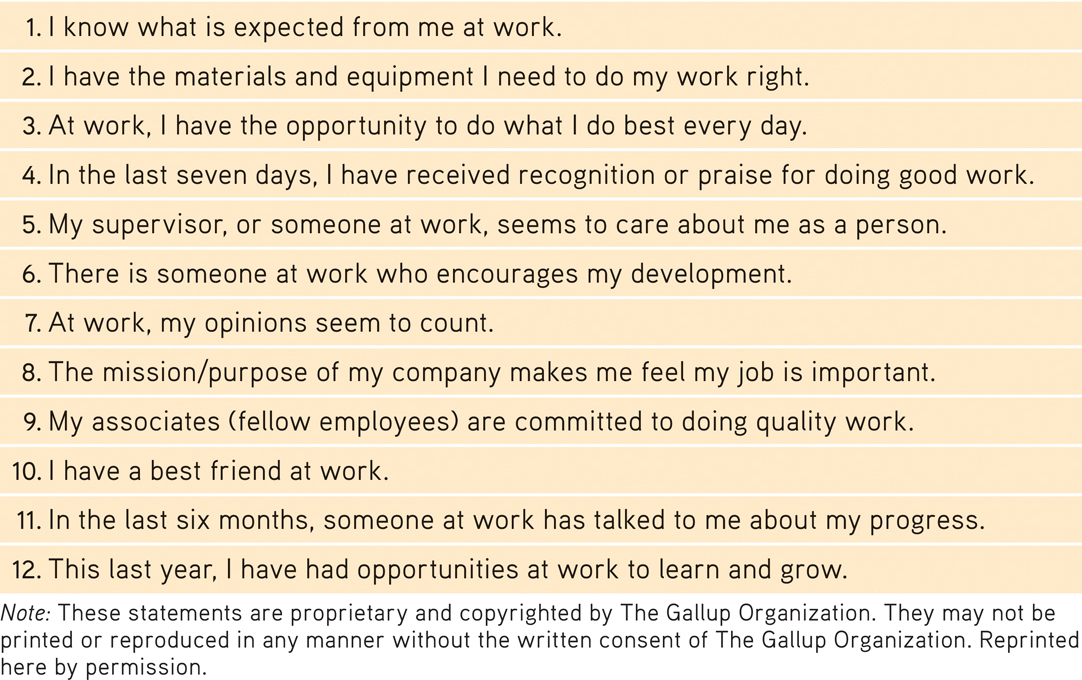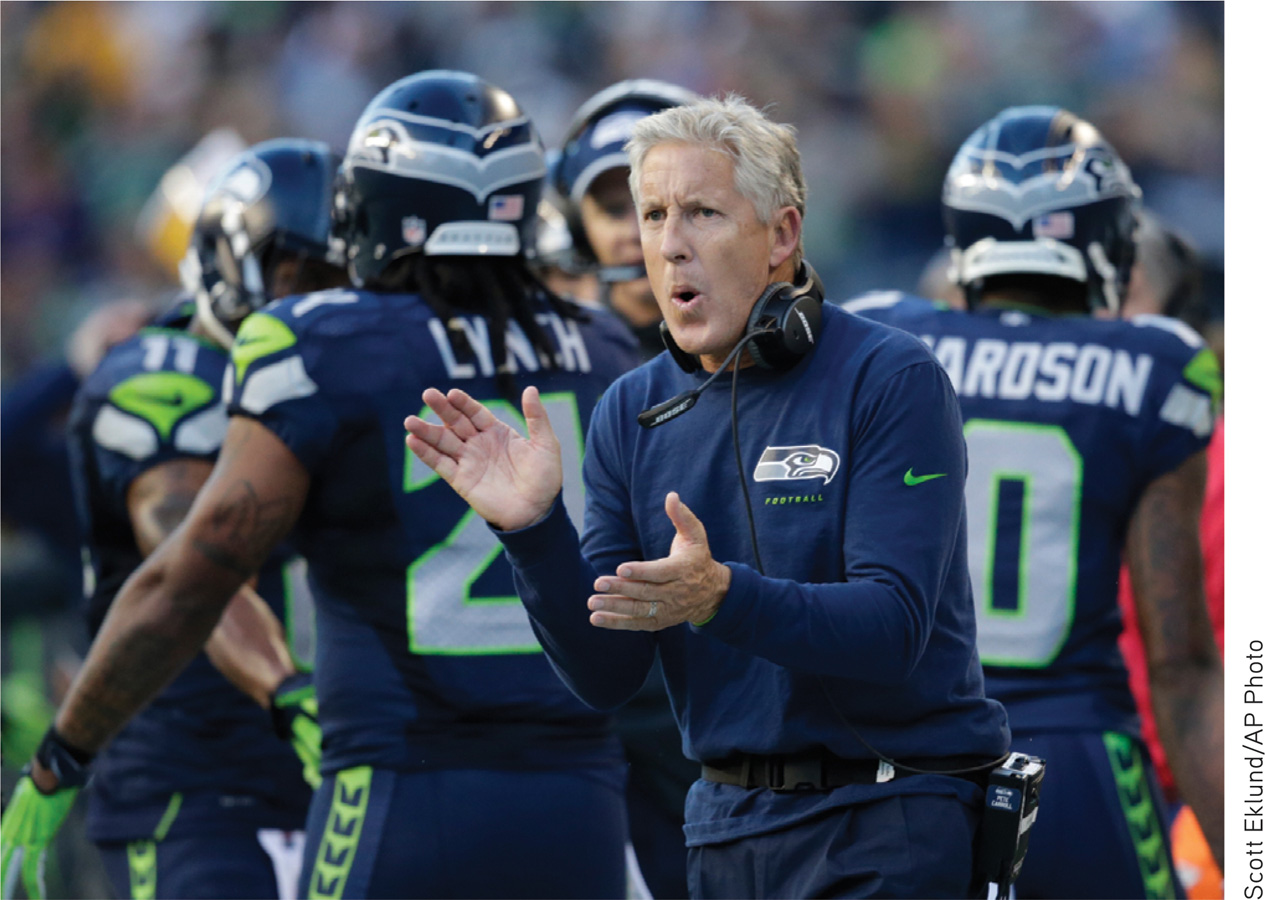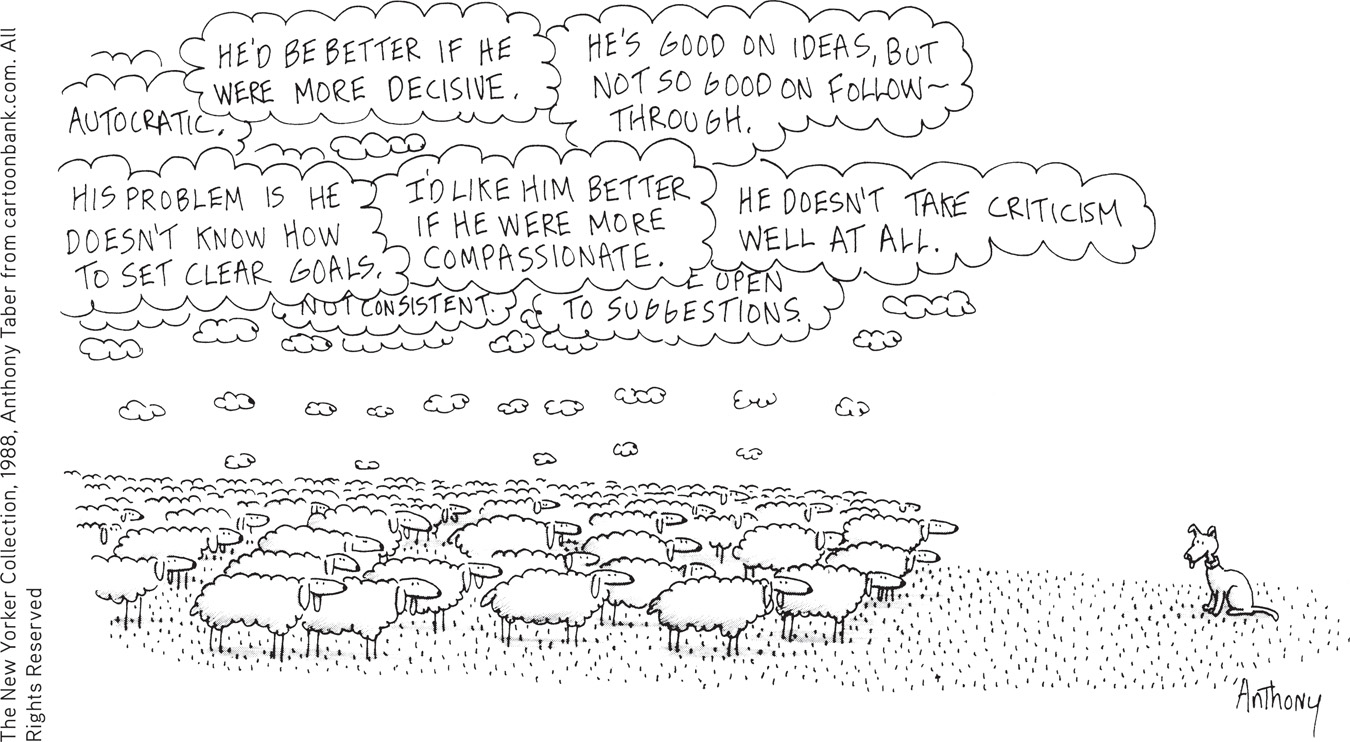Satisfaction and Engagement
Partly because work is such a big part of life, I/O psychologists study employee satisfaction. Satisfaction with work feeds satisfaction with life (Bowling et al., 2010). Moreover, as health psychologists tell us, decreased job stress feeds improved health.
“The only place success comes before work is in the dictionary.”
Former Green Bay Packers football coach Vince Lombardi
Satisfied employees also contribute to successful organizations. Positive moods at work enhance creativity, persistence, and helpfulness (Ford et al., 2011; Shockley et al., 2012). Are engaged, happy workers also less often absent? Less likely to quit? Less prone to theft? More punctual? More productive? Conclusive evidence of satisfaction’s benefits is, some have said, the Holy Grail of I/O psychology. Statistical digests of prior research have found a modest positive correlation between individual job satisfaction and performance (Judge et al., 2001; Ng et al., 2009; Parker et al., 2003). In one analysis of 4500 employees at 42 British manufacturing companies, the most productive workers tended to be those in satisfying work environments (Patterson et al., 2004). Happy workers are usually good workers. But does satisfaction produce better job performance? The debate continues.
Page A-9
Nevertheless, some organizations do have a knack for cultivating more engaged and productive employees. In the United States, the Fortune “100 Best Companies to Work For” have also produced markedly higher-than-average returns for their investors (Fulmer et al., 2003). Other positive data come from the biggest-ever I/O study, an analysis of Gallup data from more than 198,000 employees (TABLE A.2) in nearly 8000 business units of 36 large companies (including some 1100 bank branches, 1200 stores, and 4200 teams or departments). James Harter, Frank Schmidt, and Theodore Hayes (2002) explored correlations between various measures of organizational success and employee engagement—the extent of workers’ involvement, enthusiasm, and identification with their organizations (TABLE A.3). They found that engaged workers (compared to disengaged workers who are just putting in time) knew what was expected of them, had what they needed to do their work, felt fulfilled in their work, had regular opportunities to do what they do best, perceived that they were part of something significant, and had opportunities to learn and develop. They also found that business units with engaged employees had more loyal customers, lower turnover rates, higher productivity, and greater profits.
Page A-10
But what causal arrows explain this correlation between business success and employee morale and engagement? Does success boost morale, or does high morale boost success? In a follow-up longitudinal study of 142,000 workers, researchers found that, over time, employee attitudes predicted future business success (more than the other way around) (Harter et al., 2010). Another analysis compared companies with top-quartile versus below-average employee engagement levels. Over a three-year period, earnings grew 2.6 times faster for the companies with highly engaged workers (Ott, 2007).
Managing Well
A-4 What are some effective leadership techniques?
Every leader dreams of managing in ways that enhance people’s satisfaction, engagement, and productivity and their organization’s success. Effective leaders harness job-relevant strengths, set goals, and choose an appropriate leadership style.
Harnessing Job-Relevant Strengths
“The major challenge for CEOs over the next 20 years will be the effective deployment of human assets,” observed Marcus Buckingham (2001). That challenge is “about psychology. It’s about getting [individuals] to be more productive, more focused, more fulfilled than [they were] yesterday.” The first step, he and others have maintained, is selecting the right people, followed by discerning employees’ natural talents, adjusting work roles to suit those talents, and developing talents into great strengths (FIGURE A.3). Consider the faculty at a given college or university. Should everyone be expected to teach the same course load, advise the same number of students, serve on the same number of committees, and engage in the same amount of research? Or should each job description be tailored to harness a specific person’s unique strengths?
Given that our temperament and our traits tend to follow us through our lives, managers would be wise to spend less time trying to instill talents that are not there and more time developing and drawing out those that are there (Tucker, 2002). Managers who excel
- start by helping people identify and measure their talents.
- match tasks to talents and then give people freedom to do what they do best.
- care how their people feel about their work.
- reinforce positive behaviors through recognition and reward.
Thus, rather than focusing on weaknesses and packing people off to training seminars to fix those problems, effective managers focus training time on educating people about their strengths and building upon them (which means not promoting people into roles ill-suited to their strengths). In Gallup surveys, 77 percent of engaged workers, and only 23 percent of not-engaged workers, strongly agreed that “my supervisor focuses on my strengths or positive characteristics” (Krueger & Killham, 2005).
Celebrating engaged and productive employees in every organizational role builds upon a basic principle of operant conditioning: To teach a behavior, catch a person doing something right and reinforce it. It sounds simple, but many managers are like parents who, when a child brings home near-perfect exam scores, focus on the one low score in a troublesome biology class and ignore the rest. “Sixty-five percent of Americans received NO praise or recognition in the workplace last year,” reported the Gallup Organization (2004).
The bottom line: In the workplace, great managers support employees’ well-being. By caring about their employees and engaging and affirming their strengths, they support happier, more creative, more productive workers with less absenteeism and turnover (Amabile & Kramer, 2011; De Neve et al., 2013). People less often leave bad companies than bad managers (Busteed, 2012). Moreover, the same principles affect college students’ satisfaction, retention, and future success (Larkin et al., 2013; Ray & Kafka, 2014). Students who feel supported by caring friends and mentors, and engaged in their campus life, tend to persist and ultimately succeed during and after college.
Setting Specific, Challenging Goals
Specific, challenging goals motivate achievement, especially when combined with progress reports (Johnson et al., 2006; Latham & Locke, 2007). Specific, measurable objectives, such as “finish gathering the history paper information by Friday,” serve to direct attention, promote effort, motivate persistence, and stimulate creative strategies.
When people state goals together with subgoals and implementation intentions—action plans that specify when, where, and how they will march toward achieving those goals—they become more focused in their work, and on-time completion becomes more likely (Burgess et al., 2004; Fishbach et al., 2006; Koestner et al., 2002). Through a task’s ups and downs, people best sustain their mood and motivation when they focus on immediate goals (such as daily study) rather than distant goals (such as a course grade). Better to have one’s nose to the grindstone than one’s eye on the ultimate prize (Houser-Marko & Sheldon, 2008).
task leadership goal-oriented leadership that sets standards, organizes work, and focuses attention on goals.
Thus, before beginning each new edition of this book, our author-editor-staff team manages by objectives—we agree on target dates for the completion and editing of each draft. If we focus on achieving each of these short-term goals, the prize—an on-time book—takes care of itself. So, to motivate high productivity, effective leaders work with people to define explicit goals, subgoals, and implementation plans, and then provide feedback on progress.
Choosing an Appropriate Leadership Style
Leadership varies from a boss-focused directive style to an empowered-worker democratic style in which people cooperate in setting goals and developing strategies. Which works best depends on the situation and the leader. The best leadership style for leading a discussion may not be the best style for leading troops on a charge (Fiedler, 1981). Moreover, different leaders are suited to different styles. Some excel at task leadership—setting standards, organizing work, and focusing attention on goals. Being goal-oriented, task leaders are good at keeping a group centered on its mission. Typically, they have a directive style, which can work well if the leader is bright enough to give good orders (Fiedler, 1987).
Page A-12
social leadership group-oriented leadership that builds teamwork, mediates conflict, and offers support.
Other managers, many of whom are women, excel at social leadership—explaining decisions, mediating conflicts, and building high-achieving teams (Evans & Dion, 1991; Pfaff et al., 2013). Social leaders often have a democratic style: They delegate authority and welcome team members’ participation. Many experiments show that social leadership and team-building increases morale and productivity (Shuffler et al., 2011, 2013). Subordinates usually felt more satisfied and motivated, and performed better, when they participated in decision making (Cawley et al., 1998; Pereira & Osburn, 2007). Moreover, when members are sensitive to one another and participate equally, groups solve problems with greater “collective intelligence” (Woolley et al., 2010).
Because effective leadership styles vary with the situation and the person, the once-popular great person theory of leadership—that all great leaders share certain traits—now seems overstated (Vroom & Jago, 2007; Wielkiewicz & Stelzner, 2005). The same coach may seem great or inferior depending on the strength of the team and its competition. But a leader’s personality does matter (Zaccaro, 2007). Effective leaders tend to be neither extremely assertive (impairing social relationships) or unassertive (limiting task leadership) (Ames, 2008). Effective leaders of laboratory groups, work teams, and large corporations have also been found to exude a charisma that blends a goal-based vision, clear communication, and optimism that inspires others to follow (House & Singh, 1987; Shamir et al., 1993).
“Good leaders don’t ask more than their constituents can give, but they often ask—and get—more than their constituents intended to give or thought it was possible to give.”
John W. Gardner, Excellence, 1984
In one study of 50 Dutch companies, the firms with highest morale had chief executives who most inspired their colleagues “to transcend their own self-interests for the sake of the collective” (de Hoogh et al., 2004). Transformational leadership of this kind motivates others to identify with and commit themselves to the group’s mission. Transformational leaders, many of whom are natural extraverts, articulate high standards, inspire people to share their vision, and offer personal attention (Bono & Judge, 2004). The frequent result is more engaged, trusting, and effective workers (Turner et al., 2002). As leaders, women more than men tend to exhibit transformational leadership qualities. Alice Eagly (2007, 2013) believes this helps explain why companies with female top managers have tended to enjoy superior financial results, even after controlling for such variables as company size.
Page A-13
Data compiled from studies in India, Taiwan, and Iran indicating that effective managers—whether in coal mines, banks, or government offices—often exhibit a high degree of both task and social leadership (Smith & Tayeb, 1989). As achievement-minded people, effective managers certainly care about how well work is done, yet at the same time they are sensitive to their subordinates’ needs. Workers in family-friendly organizations that offer flexible-time hours report feeling greater job satisfaction and loyalty to their employers (Butts et al., 2013; Roehling et al., 2001).
A work environment that satisfies one’s need to belong also energizes employees. Employees who enjoy high-quality colleague relationships also engage their work with more vigor (Carmeli et al., 2009). Gallup researchers have asked more than 15 million employees worldwide if they have a “best friend at work.” The 30 percent who do “are seven times as likely to be engaged in their jobs” as those who don’t, report Tom Rath and James Harter (2010). And, as we noted earlier, positive, engaged employees are a mark of thriving organizations.
Increased employee participation in decision making is part of a management style that has spread from Sweden and Japan to many other locations (Naylor, 1990; Sundstrom et al., 1990). Although managers often think better of work they have directly supervised, studies reveal a voice effect: Given a chance to voice their opinion and to be part of a decision-making process, people have responded more positively to the decision (van den Bos & Spruijt, 2002). They also feel more empowered, and are likely, therefore, to be more creative and committed (Hennessey & Amabile, 2010; Seibert et al., 2011).
The ultimate in employee participation is the employee-owned company. One such company in my town, the Fleetwood Group, is a 165-employee manufacturer of educational furniture and wireless electronic clickers. When its founder gave 45 percent of the company to his employees, who later bought out other family stockholders, Fleetwood became one of America’s first companies with an employee stock ownership plan (ESOP). Today, every employee owns part of the company, and as a group they own 100 percent. The more years employees work, the more they own, yet no one owns more than 5 percent. Like every corporate president, Doug Ruch works for his stockholders—who also just happen to be his employees.
As a company that endorses faith-inspired “servant leadership” and “respect and care for each team member-owner,” Fleetwood is free to place people above profits. Thus, when orders lagged during a recession, the employee-owners decided that job security meant more to them than profits. So the company paid otherwise idle workers to do community service—answering phones at nonprofit agencies, building Habitat for Humanity houses, and the like.
Fleetwood employees “act like they own the place,” notes Ruch. Employee ownership attracts and retains talented people, “drives dedication,” and gives Fleetwood “a sustainable competitive advantage,” he contends. With stock growth averaging 17 percent a year, Fleetwood was named the 2006 National ESOP of the year.
We have considered personnel psychology (the I/O subfield that focuses on employee selection, placement, appraisal, and development). And we have considered organizational psychology (the I/O subfield that focuses on worker satisfaction and productivity, and on organizational change). Finally, we turn to human factors psychology, which explores the human-machine interface.
Page A-14


 Table A.3
Table A.3
 Table A.2
Table A.2

 Figure A.3
Figure A.3
